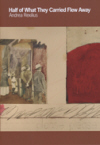Half of What They Carried Flew Away
All throughout Half of What They Carried Flew Away, Andrea Rexilius proves her command of words and sentences. Mostly, the process of her creating is hidden by its resulting prose poems and declarative stanzas. One passage, however, lifts the curtain: “These borders live on, interrelated. Between the body’s procreation and use. I have been told, it is unfair to say the word ‘body’ again. That’s fine. It’s easy enough to ignore.”
All throughout Half of What They Carried Flew Away, Andrea Rexilius proves her command of words and sentences. Mostly, the process of her creating is hidden by its resulting prose poems and declarative stanzas. One passage, however, lifts the curtain: “These borders live on, interrelated. Between the body’s procreation and use. I have been told, it is unfair to say the word ‘body’ again. That’s fine. It’s easy enough to ignore.”
A writer may recognize these last few sentences as a defensive reaction to a workshop comment that could have referred to Rexilius’s repetition of a word or two within a single short poem. And one can’t help but recognize, too, the irony in her defense. Even as she punctuates “ignore,” the many repeated words, phrases and ideas in Half of What They Carried receive a spotlight beyond the glow given by a simple repeat.
Despite, or because of, the special attention given to the repeated words, it’s clear Rexilius has every right to defend them. Half of What They Carried Flew Away is a prime example of what a writer can do with repetition, whether within one tightly-spaced poem or across an entire collection. While one technique is swiftly spinning expansive leitmotifs, the other is undermining, stripping words of assumed definitions, adding more, beginning again.
The poem “There are two worlds . . .” helps to further explain how Rexilius feels toward words, as it deconstructs “blue”:
They are referring to negation, to the deepest blue. But it’s hard to get the blue of this sky, they say. Is it the same blue as that blue over there? It is true, they think, to question the language the blue has given them. . . . What is this blue called, they wonder. What is that blue.
(Also see the early lament, on page four, of language’s inability to capture an idea: “‘Please’ they cried: ‘we can’t really describe movement.’”)
The most frequently repeated words in the book are “they” and “I,” yet the ambivalent pronouns are also the most often defined:
They are from the early 1870s.
They move from house to house like windows.
They rise and fall.
They are a demonstration.
They continue to drift.
Their—the pronouns’—mystery separates the speaker from subject in a way that parallels the distance between a signifier and its signified, but it also suggests the complications in understanding and relating to other people, and to oneself: “I am yellow, or red. / I was asked if I am myself. / I am myself.”
Half of What They Carried Flew Away is two stories: it is people looking for identity, and it is the identity of words flaking off.





